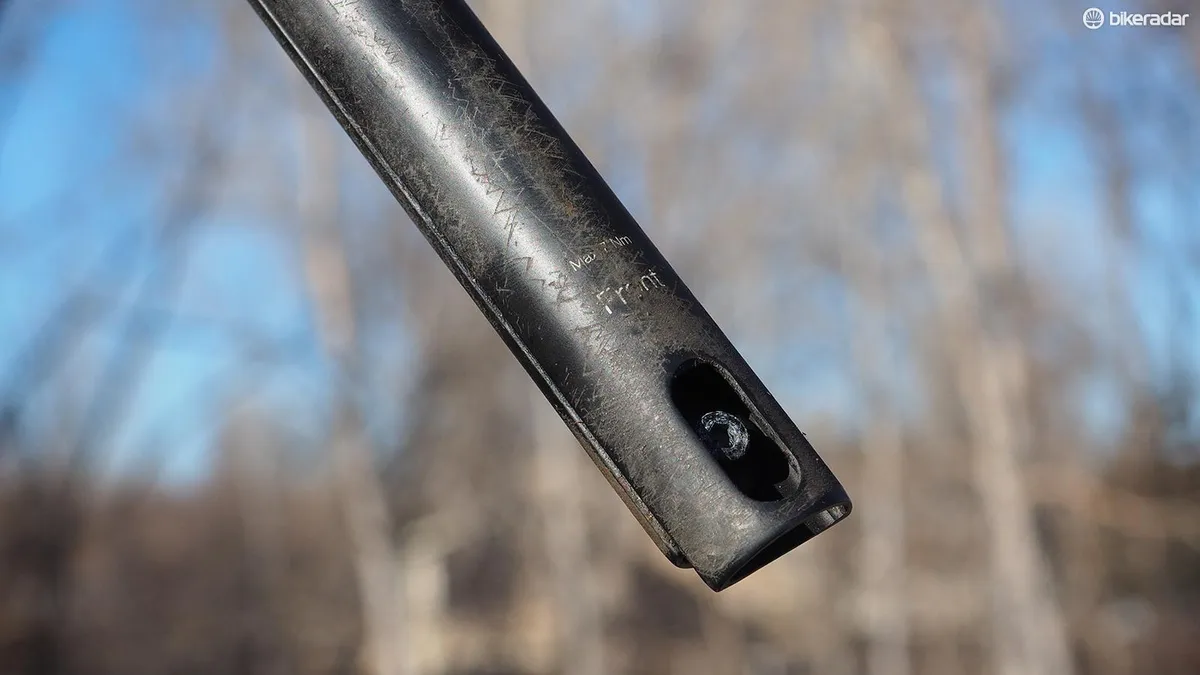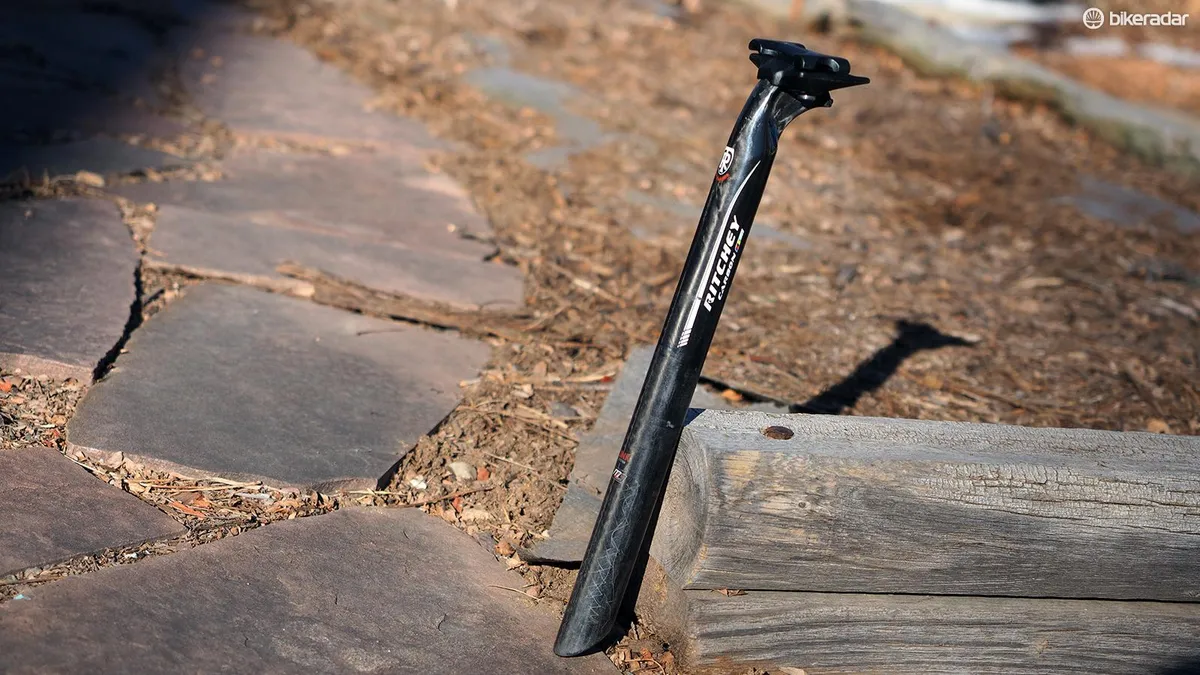There are lots of seatpost options these days that promise a more comfortable ride without the complication (and weight) of mechanical pivots or sliding bits. But which ones actually work, and which are just hype? We enlisted the help of Microbac Laboratories in Boulder, Colorado to find out which of the new crop of soft-riding rigid seatposts does the best job of saving your butt.
For all the work that road bike designers put into making their frames more comfortable, the simple fact remains that their triangulated tube layouts make them inherently resistant to movement under vertical loads. Seatposts, on the other hand, are simple cantilevered tubes with no additional bracing, meaning they’re free to flap about in the breeze and far more apt to move when you hit something.

A bicycle frame's triangulated arrangement of tubes doesn't allow for much flex. A seatpost, however, is much more free to move under load
Of course, all seatposts are not created equal – even when they share critical dimensions such as diameter and length – and component engineers have recently started to capitalise more thoroughly on the design possibilities of carbon fibre composites. Fibre lay-ups and even the fibre types themselves can be tuned to allow more flex in one plane than another, for example, while more elaborate designs cleverly incorporate mechanisms to promote movement without the complexity (and weight) of physical pivots, springs, and dampers.
Road bikes don’t generally have to deal with much in terms of bump amplitude, though, so while some companies have focused on taking the edge off of bigger hits, others have decided to concentrate on canceling out annoying vibrations that come with coarsely paved asphalt – that incessant buzzing that might not have much effect at first but can really become irritating after a couple of hours.

Microbac Laboratories in Boulder, Colorado used a custom saddle jig to test five soft-riding seatpost options
BikeRadar identified five of the most promising options available and sent them off to Microbac Laboratories. There, engineer Richie Trent subjected them all to a battery of static load testing using an industry-standard MTS servo-hydraulic actuator and a custom-made jig, plus vibration testing using on-board accelerometers. All proved better than a benchmark aluminum post but some were certainly better than others.
The contenders
- Canyon VCLS: Canyon’s entry has actually been around for several years now – so long, in fact, that the company no longer offers it as an aftermarket product but still includes it on many of its complete bikes. Instead of only using carbon fibres in this post, Canyon incorporates a mix of carbon and basalt fibres in a specific lay-up pattern that supposedly allows for lots of flex fore and aft but not side to side.
OEM only, 27.2x330mm, 223g

- Ergon CF3 Pro Carbon/ Canyon VCLS 2.0: Offered as both the Ergon CF3 Pro Carbon and the Canyon VCLS 2.0 (respective company heads Frank Arnold and Roman Arnold are brothers), this rather ingeniously designed seatpost splits the usual cylindrical cross-section into two halves. In essence, this creates two flat leaf springs that are inherently more prone to move upon impact but without adding undue bulk or mass. This is strictly a road/CX-only model, though, as it’s explicitly not approved for mountain bike use and carries a 100kg (220lb) rider-plus-gear weight limit.
$n/a / £150 / €200 / AU$285, 27.2x330mm, 233g

- Ritchey WCS Carbon Link FlexLogic: Much like the Canyon VCLS, Ritchey’s entry looks like any other typical carbon fibre seatpost from the outside. Beneath the skin, though, Ritchey says the fibre plies have been tuned to be more flexible under load over the company’s standard carbon offerings – by as much as 15% based on claims. The interchangeable head accepts Ritchey’s single-rail saddles, too, and this model is by far the lightest of the bunch.
$210 / £160 / €210 / AU$345, 27.2x350mm, 161g

- Specialized CG-R: Certainly the most unusual looking of the bunch, the CG-R incorporates a pivotless carbon hinge up top plus an elastomer wedge that Specialized says provides up to 18mm of vertical movement along with “unsurpassed comfort, control, and efficiency without adding weight or complication to the frame.” As promised, it’s certainly light and the location of the flex mechanism doesn’t require much seatpost extension, which could be a boon for shorter riders.
$200 / £150 / €190 / AU$250, 27.2x350mm, 245g

- Syntace P6 Carbon HiFlex: This seatpost follows the same philosophy as the Ritchey, resorting to careful fibre orientations to promote a smoother ride – “twice the shock absorption capabilities in the riding direction as previously”, at least according to Syntace. Notably, this is the longest seatpost in our test and carries no usage restrictions or weight limit so it’d also be a viable option for trail riding.
$249 / £189 / €250 / AU$325, 27.2x400mm, 231g

- Thomson Elite: This stalwart model served as the benchmark for our test – a machined aluminum seatpost that has proven itself to be one of the most popular premium models ever produced as well as one of the most durable. We also chose this model for its well-documented firm ride quality. If ever there was a standard to be measured by, this is it.
$100 / £80 / €108 / AU$138, 27.2x330mm, 236g

The results
The Ergon CF3/Canyon VCLS 2.0 performed the best in the static load tests, at both the maximum and minimum insertion depths. Simply put, the twin flat sections allowed for far more movement than any of the other contenders – a fact that was not only verified in the test jig but also supported by feedback from test riders.

The Ergon/Canyon seatpost was the clear winner in terms of deflection under load
In addition, the Ergon/Canyon post was not only the most effective at removing the sting from bump impacts, its advantage only grew with increasing loads. In other words, it was great at neutralizing smaller impacts but truly exceptional at taking the sting out of bigger ones.
Even better, test riders weren’t at all put off by the CF3/VCLS 2.0 post’s movement.
Coming in a tight second place is the Canyon VCLS, which trailed the Ergon/Canyon model surprisingly closely when the seatposts were tested at their maximum insertion depths while still trouncing the Syntace, Ritchey, and Specialized at the minimum insertion depth. If you’re after a soft-riding seatpost that still looks somewhat normal, this would be our pick.

Some of the seatposts performed markedly differently depending on how much seatpost was sticking out of the frame
Things become a little more muddled in terms of static loads when you look at the rest of the field. The Syntace did quite well when tested at its minimum insertion depth, for example, but fell to last place when the posts were shoved further into the test frame, which supports the notion that its flex pattern is distributed more evenly along the entire length of the seatpost shaft.
The Ritchey landed mid-pack in both tests, making it a good option for riders who might want to just soften things up a bit.
The Specialized was the surprise backmarker of the field, beating only the Syntace when the posts were at full extension and coming in dead last when fully inserted. The unique pseudo-pivoting head does work – it still beat the Thomson handily, after all – but as test rider feedback confirmed, it’s primarily only effective on bigger impacts or under heavier riders.
But what about vibration damping? Here’s where things get really interesting.

While the Ritchey seatpost didn't do particularly well in terms of deflection, it's very good at absorbing vibrations
Once again, the Ergon CF3/Canyon VCLS 2.0 easily walks away with the prize here, not only absorbing the most vibration during our prescribed test loop based on data collected by on-board accelerometers during two trial runs but also subjectively providing the smoothest ride quality.
The older Canyon VCLS once again does really well and as before, the Syntace and Specialized still do far better than the Thomson but lag the others in this field. The Ritchey, however, jumps up the rankings here. Whereas the WCS FlexLogic perhaps doesn’t actually flex as much as its name might suggest, our tests show that it’s very good at squelching the buzz of dirt roads or rutted tarmac.
So which one is best for you?
That answer likely depends on what you’re looking for as well as how you’re built. If you’re after the smoothest-possible ride and fit within the rider weight restrictions, the Ergon CF3/Canyon VCLS 2.0 is the clear runaway winner. It moves the most under bigger impacts and attenuates the most vibration of any of the seatposts in this test. If you can’t handle its somewhat odd appearance but are still after maximum cush, try and find the earlier-generation Canyon VCLS model instead as it’s nearly as good but not nearly as odd-looking.
“It is clear to me that the Ergon CF3/Canyon VCLS 2.0 takes the cake,” says Trent. “After spending time in the saddle with this post, I was/am amazed at how comfortable it makes the ride. The deflection results for the Ergon can be deceiving. Is it really a good thing to have a post flexing that much? Could it act more like a pogo stick than a damper? Well, I think the vibration results back up the lab-based deflection and qualitative field data in a big way.
“My second pick would be the Canyon VCLS post," Trent adds. "It may actually be my favorite given its unassuming guise. It flexed a lot under loads, ranked third in vibration testing, and felt comfortable while riding.”

Winner!
More performance-minded riders who are more sensitive to added weight, however, might instead want to look at the Ritchey. Although it doesn’t fare particularly well in terms of impact, it offers a smooth ride when it comes to road buzz while being the lightest model in this test by a wide margin.
As for the Specialized, it’s perhaps best reserved for riders who still want to feel the blacktop below them but want something that handles unexpected bumps better than a typical aluminum post (tandem stokers come to mind). The Syntace, meanwhile, doesn’t stand out when viewed in a road riding context but keep in mind that many of the others in this test either aren’t approved for trail use or just aren’t long enough. At 400mm, however, the P6 HiFlex not only has extension to spare but is fully backed by Syntace for off-road fun.
Regardless, riders who are after a smoother ride than what they have now clearly have plenty of options that cost a lot less than a new bike – and now you hopefully have enough information to choose the one that best suits your own preferences.
Special thanks go to Richie Trent and the folks at Microbac Laboratories in Boulder, Colorado.




























